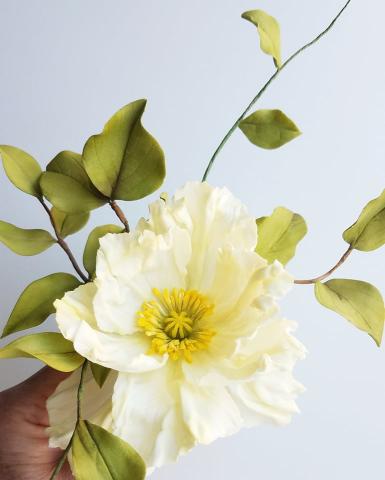Nicholas Lodge's Tylose Gumpaste
Image

This following Tylose gumpaste recipe is used for fine flower making like the flowers featured in many of the classes Nicholas teaches. Renshaw Decor‐ice gumpaste is a comparable commercially available product. The NL Brand Commercial Gumpaste that he references and uses during classes is a softer formula used on gumpaste used for more basic flowers. It is also used for mixing with scratch Tylose gumpaste (or the Renshaw gumpaste) to create a paste that does not dry quite as quickly as needed for making flowers, especially with basic flowers.
Yield units
Servings
Ingredients
125 grams Egg Whites (Fresh or pasteurized)
725 grams Confectioners Sugar
100 grams Confectioners Sugar
30 grams Tylose
20 grams Vegetable Shortening (Can be Crisco)
Instructions
- Place the egg whites in a Kitchen Aid mixer bowl, fitted with the flat paddle or scraper paddle attachment.
- Turn the mixer on high speed for 10 seconds to break up the egg whites.
- Turn the mixer to the lowest speed; slowly add the 725g of powdered sugar to make a soft consistency royal icing.
- Turn up the speed to setting 3 or 4 for about two minutes.
- Make sure the mixture is at the soft‐peak stage. It should look shiny, like meringue and the peaks fall over. (If coloring the entire batch of gumpaste, add the paste, gel or liquid color at this stage, making it a shade darker than desired.) Also, white gel color can be added to make a brighter, whiter gumpaste.
- Turn the mixer to the slow setting and sprinkle the Tylose in over a 5 second time period. Turn the speed up to the high setting for a few seconds. This will thicken the mixture.
- Scrape the mixture out of the bowl onto a work surface that has been sprinkled with some of the reserved 100g of powdered sugar. Place shortening on your hands and knead the paste, adding enough of the reserved powdered sugar to form a soft but not sticky dough. You can check by pinching with your fingers and they should come away clean. Place the finished paste in a zip‐top bag, then place the bagged paste in a second bag and seal well.
- Mature the gumpaste for 24 hours if possible before use, keeping in a cool environment.
- When you are ready to use the paste, cut off a small amount and knead in a little vegetable shortening into the paste. If coloring at this stage, knead the color into the paste until the desired shade is achieved.
- When not in use, the paste will need to be stored in the refrigerator. Before use, remove from refrigerator and allow the paste to come to room temperature. Knead a small amount of shortening into the paste.
- Always store the paste vacuum‐sealed with a food‐saver type system if available, or in zip‐top bags with as much air removed as possible. Wrapped in plastic wrap like this, the paste will keep under refrigeration for approximately 6 months. You can keep the paste longer by freezing it. Be sure to use zip‐top freezer bags. If you will be freezing a batch of paste, allow it to mature for 24 hours before placing into the freezer. The paste can be kept in the freezer for several years with no problems and can be taken out of the freezer, thawed, used and refrozen without any problems or ill effect on the paste.
- Less Tylose can be used if you do not want the gumpaste to dry as fast or if making dark colors that typically dry the gumpaste out, (i.e. Black, Dark Green, Purple.)
